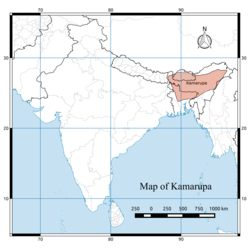Kamarupa Kingdom
| Kamarupa Kingdom | ||||||||||||||||
|
||||||||||||||||
|
This is the 7th and 8th century extent of Kamarupa kingdom in Assam, Bhutan and Bengal. Kamarupa at its height covered the entire Brahmaputra Valley, North Bengal, Bhutan and parts of Bangladesh, and at times portions of West Bengal and Bihar.
|
||||||||||||||||
| Capital |
Pragjyotishpura Haruppeswara Durjaya |
|||||||||||||||
| Government | Absolute monarchy, unitary state | |||||||||||||||
| Historical era | Classical India | |||||||||||||||
| • | Established | 350 | ||||||||||||||
| • | Disestablished | 1140 | ||||||||||||||
|
||||||||||||||||
| Today part of |
|
|||||||||||||||
|
|
|
|
|---|
 |
|
|
Kāmarūpa (/ˈkɑːməˌruːpə/; also called Pragjyotisha), was a middle kingdom on the Indian subcontinent; and along with Davaka, the first historical kingdom of Assam, India. Though Kamarupa existed from 350 to 1140 CE, Davaka was absorbed by kamarupa in the 5th century. Ruled by three dynasties from their capitals in present-day Guwahati, North Guwahati and Tezpur, Kamarupa at its height covered the entire Brahmaputra Valley, North Bengal, Bhutan and parts of Bangladesh, and at times portions of West Bengal and Bihar.Though the historical kingdom disappeared by 12th century to be replaced by smaller political entities, the notion of Kamarupa persisted and ancient and medieval chroniclers continued to call this region by this name. In the 16th century the Ahom kingdom came into prominence and assumed for itself the political and territorial legacy of the Kamarupa kingdom.
The name of this kingdom survives in Kamrup, a present-day district in Assam.
Kamarupa and the northeast Indian region find no mention in the Ashokan records (3rd century BCE). The first dated mention comes from the Periplus of the Erythraean Sea (1st century) where it describes a people called Sêsatai. The second mention comes from Ptolemy's Geographia (2nd century) calls the region Kirrhadia after the Kirata population. The first historical mention of the kingdom comes from the 4th-century Allahabad inscription of Samudragupta that calls the kings of Kamarupa (Western Assam) and Davaka (now in Nagaon district) frontier rulers (pratyanta nripati). The Chinese traveler Xuanzang visited the kingdom in the 7th century, then ruled by Bhaskar Varman. The corpus of Kamarupa inscriptions left by the rulers of Kamarupa, including Bhaskar Varman, at various places in Assam and present-day Bangladesh are important sources of information. Nevertheless, local grants completely eschew the name Kamarupa; instead they use the name Pragjyotisha, with the kings called Pragjyotishadhipati.
...
Wikipedia

